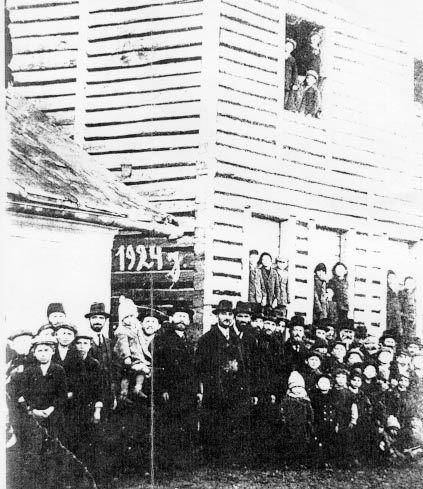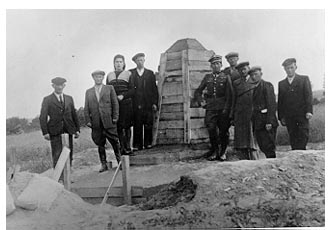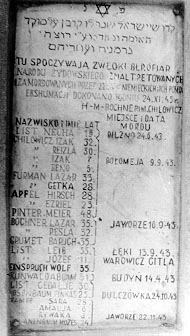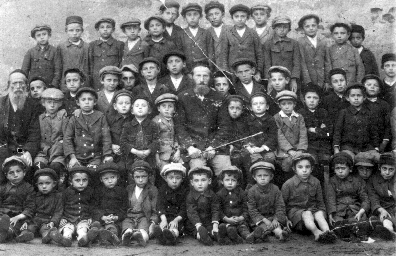Maurice Chilowicz and the Story of
Pilzno.
Compiled from:
Letter from Maurice Chilowicz to Harry Kranz,
May 5, 1986; and
Interview by Sharlene Kranz, Forest Hills, NY,
Jan. 18, 1999
I was born in Pilzno on Dec. 22, 1918. My Jewish name is Moshe
Yankele. My father's name was David Chilowicz, my mother
Sabina. My father was born in 1885. His brother Itzhak
and his sister Esther Kirschbaum came to the U.S. before the
war. I had four brothers and a sister. My father is
not in the 1924 synagogue photo. He had no time for that, he
was a businessman, a wholesale grocer. He was on the city
council. My father supported half the town. On Mondays
for market day, people borrowed money from my father to buy
merchandise, then after the market they paid him back.
The towns around Pilzno were very small, smaller than
villages. The Jews were clustered in Pilzno. They came
for the High Holy Days to Pilzno from the little villages. Most
of the Jews were merchants, some had cows, a horse to come to
town. Pilzno had 150 Jewish families, about 600 people.
The pictures from 1924 were taken the same day to show the
people in America what their money had built. Our rabbi was
Menasha Horowitz.
-

-
- This photo was taken in 1924 at the dedication of the new
Talmud Torah, built with funds from the New York Pilzno Society,
to send to New York.
Some of the men in the photo are (left to right): Shlomo
Tulipan, Montag Eisenberg, Mechel Stern, Abraham Tirk, Abraham
Abraham, Mendel Eisenberg, Meier Lerner, Yacov Katzner, David
North, Mr. Grafschrift, Zelig Derszowitz, Moishe Aaron Kranz,
Moshe Linder, and Gershon Bodner.
(Identified by Arye Bodner of Israel).
My life in Pilzno till 1939 was not bad. I was the youngest
of five brothers, and the only one who was a chasid. I wore
a black coat and payes. We had a good
business, but it started to cloud with Hitler as a Polish
neighbor. I worked in my father's business and attended
Talmud Torah. I was in Pilzno in 1939 when the Nazis invaded
Pilzno. I lived with them for two months, then smuggled
myself across the German-Russian border to Lwow and deported to
Siberia. In 1943 I was mobilized to the Polish Army.
My immediate family perished in different places. About 50
or 60 people of the town survived by hiding out, hidden by Poles;
some survived concentration camps and in Russia.
The story in Harry Kranz's letter about his visit to Pilzno, which
says that Chilowicz refused to come out of it and was burned to
death inside when the Germans torched the synagogue is not
true. Here is what happened to my brother:
On Erev Rosh Hashanah my brothers and I stayed hidden in the
back of our house. My father went to the bath house at 1pm,
that day the S.S. came to town, my father came home with a shaved
beard. The soldiers came in the back of our store. We
five brothers were ready to go to a neighbor's (Adler's) for
the evening prayers.
Two S.S. came in the back of our store and said to us raise your
hands. The soldiers came in, they stole shoe paste and
a pack of chocolates. They handed the package to my oldest
brother Mottel to carry. Mottel said he had a bad back and
handed the package to another brother, Aaron. My mother said
he would get caught in the curfew .
So Aaron went with the package, about 7 pm; later some
other cousins came over. By 11pm Aaron wasn't home
yet. At 3am my mother went out to look for him. The
soldiers were staying in the public school. Mother went to
the school, but Aaron was not there. She went looking at the
Agriculture School, on the way to the synagogue. A Polack (a
friend), told her there was a body in the shul, in the back.
She went to look and found Aaron dead. He was shot in the
front. She buried him in the Jewish cemetery that night.
On the second night of Rosh Hashanah the Germans burned the
Talmud Torah. After that we were sitting shiva. Erev Yom
Kipper my parents were taken out by the solders to clean the
streets.
I went to Einspruch's for awhile. Two weeks later I came
home, then after four weeks my brother and I decided to go to the
Russian side. I couldn't take life under the Germans
anymore. The war started on Sept. 1, and on Sept. 8, a Friday, the
Germans came to Pilzno. I left 3 months later. After
awhile, they organized to pull out the Jews from the street.
They took my parents right away to the train station, and they
killed them right away.
From 1939 to 1942 everything was normal. A committee was
organized to tell who would work. Three men were on the Juden Rat:
Hershel Bochner, Zanita Weissman, and Mundich Treibish.. In
1942 they liquidated the Jews, took away my father's store, they
chased everyone out from the houses, and took them away to
Dembitz. The younger ones they took to work in the
factories. When they liquidated the Pilzno ghetto my family
and other families found themselves places to hide. First we
had a small ghetto in Pilzno, then in Dembitz. The older
people they packed into the trains to Belzec. Hershel
Bochner's family and other families they ran away into a
bunker. My family secured also a bunker. But my
mother and father and one sister disappeared down there (in
the Pilzno ghetto). My oldest brother they took away in 1940
because somebody squealed on him that he was in Germany. He
was in Germany from 1928 to 1932, and he just disappeared, and his
two children were left.
In the bunker there were my brother Itzak and his
wife Raizel Chilowicz, with my oldest brother's two
children, and Gitka Furman my sister, and her
husband. They were in a bunker with 6 or 7 people next to
the Bochner's bunker. Shushka Bochner used to tell me at night
they came out and talked to each other. My sister and her husband,
when they were hiding, they had to choke their own child, who was
crying. Somebody squealed and my family was
killed down there. (Their names are on the monument we
erected in 1945; see Photo). The Germans were looking for
dead Jews. But the sister of the guy who hid them, a stupid
girl, she showed them the living Jews . That happened Sept.
9, 1943. The Germans came in the morning, they threw
grenades into the bunker. They came out alive, and
they shot them and they shot the Polloks, too, who hid them.
My family was buried down there in the sands near the
toilet. The Polloks they took to the cemetery.
The minute the Bochners heard what happened the next night they
ran away to find another place to hide in the wilderness.
-
- My brother and I lived together, I went to the Army but he
was worried that I would not make it. He got killed two
days before the war was over, April 20, 1945. I got a
letter from him, "I'm happy I'm going to see you soon."
And the next letter came that he was dead.
-
- I was in the Polish Army. They took me, I didn't
go. They had to take me 3 times to go, I didn't
volunteer. The first Polish army organized in 1941,
the Polish officers in 1941 who trained in Iran, they
never came back. So two years later another Polish
general organized another army, this is the Army that came in
with the Russians together to liberate Poland in 1944. I
was in this Polish army. I was a Captain. They knew I was a
Jew. I was lucky. They sent me to 3 officers
schools, to learn to drive, then to be an auto
mechanic, and by the time I came back the war was almost
over. I came in 1944 straight to Poland, the war was
almost over. I had to wait for six months in Dembitz
because the Germans were still in Pilzno.. I was in
transportation, my chief of staff was a Jewish guy. I came back
in 1945 to Pilzno from the Army. First I went to Pilzno
to find out what's what. When I came a neighbor told me
what happened to my family. So I came back with an army truck
and a couple of soldiers to protect me. We brought lumber and
caskets. The Bochners showed me the mass grave of part of my
family. Together with the Bochners and other survivors we
exhumed the bodies we knew about. We exhumed those bodies
and buried them all together. I recognized my family
through their teeth after two years; they had been buried in
their underwear in a dry place, one on top of the other. Other
bodies were buried near river banks, their bodies looked like
calcium. We erected a memorial (see Photo) and left Pilzno.
-
 PHOTO TAKEN AT PILZNO JEWISH CEMETERY JUNE
1946.
PHOTO TAKEN AT PILZNO JEWISH CEMETERY JUNE
1946.
Left to right: Benjamin Derszowitz, Perec List, Leika
Bochner, Salomon Kampf, Maurice Chilowicz (in Army uniform),
Harry Bochner, Leizer Bochner (husband of Leika), Michael
Bochner (brother of Harry), and Leibish Schnaps. See Maurice
Chilowicz's description of the building of the memorial.

NAMES ON THE MONUMENT IN JEWISH CEMETERY IN PILZNO,
erected in 1946 by returnees to the town:
- "Here lie the bodies of the Jewish people who have
been killed by the Germans and their helpers. Exhumed
24.11.1945 by H and M Bochner and M. Chilowicz."
-
-
|
NAME
|
AGE
|
PLACE OF
DEATH
|
DATE OF
DEATH
|
|
LIST, NECHA
|
19
|
PILZNO
|
24.06.43
|
|
CHILOWICZ. IZAAK
|
32
|
POLOMEJA
|
9.9.43
|
|
CHILOWICZ, REIZLA
|
30
|
POLOMEJA
|
9.9.43
|
|
CHILOWICZ, IZAAK
|
7
|
POLOMEJA
|
9.9.43
|
|
CHILOWICZ, BENA
|
5
|
POLOMEJA
|
9.9.43
|
|
FURMAN, LAZAR
|
35
|
POLOMEJA
|
9.9.43
|
|
FuRMAN, GITHA
|
28
|
POLOMEJA
|
9.9.43
|
|
APFEL, HIRSH
|
28
|
POLOMEJA
|
9.9.43
|
|
APFEL, EZRIEL
|
23
|
POLOMEJA
|
9.9.43
|
|
PINTER, MEIER
|
48
|
POLOMEJA
|
9.9.43
|
|
BOCHNER, LAZAR
|
35
|
JAWORZE
|
16.9.43
|
|
BOCHNER, PESLA
|
32
|
JAWORZE
|
16.9.43
|
|
GRUMET, BARUCH
|
35
|
JAWORZE
|
16.9.43
|
|
LIST, LEIB
|
55
|
LEKI
|
15.9.43
|
|
LIST, JOZEF
|
11
|
LEKI
|
15.9.43
|
|
EINSPRUCH, WOLF
|
35
|
LEKI
|
15.9.43
|
|
WAROWICZ, GITLA
|
-
|
LEKI
|
15.9.43
|
|
KUNWALD, ABRAM
|
31
|
BUDYN
|
14.4.43
|
|
LIST, GEDALIE
|
30
|
DULCZOWKA
|
24.10.43
|
|
ROSENBAUM, PINKAS
|
25
|
DULCZOWKA
|
24.10.43
|
|
KAMPF, SARA
|
28
|
JAWORZE
|
22.11.43
|
|
KAMPF, AMALIA
|
6
|
JAWORZE
|
22.11.43
|
|
KAMPF, RYWKA
|
3
|
JAWORZE
|
22.11.43
|
|
TANENBAUM, MOSES
|
24
|
JAWORZE
|
22.11.43
|
I came to America in 1952. I worked in the garment industry,
and now I'm retired. I have two sons and two granddaughters.
Why did some survive and others not?
Everybody who is alive today is alive by luck.
Friends left, a lot of people didn't come back. Schiffman
didn't come back, Tascher didn't come back, and Browns didn't come
back.
The Bochners survived by luck. Hershel used
to shlep his mother on his back. It wasn't easy. How
many times Michael wanted to give up. Hershel wasn't God, he
couldn't save everybody, the Germans were God, not him.
I don't live in the past, the past lives in me. I haven't
been back to Pilzno. Who wants to see the blood?
Who were the Reichs?
Three Reichs were in the bunker with Leika and the other
Bochners: Tuli, Yosel, and Shlomo Reich. They all
survived. They were big guys. Their parents and sister
were killed. Leika Bochner's first husband was Chazkel
Schmier, a cousin to the Reich's.
Did you know my great-grandmother Chaya and my grandfather
Avram Leib Kranz?
I knew Chaya Kranz, your great-grandmother, we used to play
behind her house and knock on her window. She would yell at
us and we called her "Chayash Kurech", meaning a crotchety old
woman. Your great-grandmother's place was near
the Shul. Chaim Tulipan lived on one side of the shul
in a little building and Chaya Kranz lived on the other
side. The river ran behind her house. After her third
husband Gabriel Einspruch and she broke up, she had an elder woman
living with her, Rivka Bouf. Chaya was a fine, pious,
hard-working woman, a member of the society of women who
took care of preburial cleansing.
Your grandfather's name has been known to me a far as I can
remember. His name was inscribed with other names from
Pilzno Society in America on a plaque in the Talmud Torah where I
studied Talmud. I used to see him at the meetings
here. He was a powerful man, outspoken.
Did you know my grandfather's brother Moishe Aaron?
Yes. Moishe Aaron Kranz was a poor man. On Monday,
they'd come out to sell at the market, piece goods, they didn't
have a store. Ninety percent of Pilzno was
poor. One of Moishe Aaron's daughters was a widow, a
wig maker in Mishlenice. Shlomo Meyer Kranz, Moishe Aaron's
son, did gernisht (nothing) for a living. His other sons,
Avrum Leib and Chaim Zev were in Germany. Moishe
Aaron's wife Gittel Haber had a brother, Chazkel Haber, and four
sisters:
one sister married Tobey Scheyer, a Pilzno man,
one sister married Hershel Geiser,
one sister married Yattel Auterslander, they sold candy,
one sister, Raisl, married my brother Itzhak
Chilowicz, a baker.
Gitel's father was Zeesman Haber. He was deaf; he had a
bakery in Pilzno.
There were three bakeries in Pilzno: Haber, Chilowicz, and
Einspruch.
Itzhak Chilowicz's bakery is now the police station in the
marketplace.
Tell me about the Turk family.
There lived in Pilzno three Turks: Avrum Turk, Moishe
Turk, and Beryl Turk. Moishe had two daughters who survived
in Israel (one was married to a cousin of mine) and one daughter
was in Philadelphia. One married Avrum Katzner. One
married Avrum Bush, died in South America. There's Golda
Turk and Raisa Turk. Avrum Turk was wiped out
completely.
Where is the Pilzno Society burial plot?
We have plots at Montefiore Cemetery, in Queens, and at New
Montefiore, on Long Island. There is also a Pilzno plot at
Mt. Moriah Cemetery in Fairview, NJ (201- 943-6163). Of the
Pilzno Society there is only now me and Bill Seiden, and he is 96
years old.
What would you like remembered about Pilzno?
I like to remember the joy of a small town, a big family lived
together, enjoyed together, suffered together, and perished apart.
PHOTO OF TALMUD TORAH SCHOOL
OF PILZNO, 1924
Photo donated by
Maurice Chilowicz. Students identified by Maurice
Chilowicz.

Top Row, left to right: Chaim Baum, Shloime Mechlevicz,
Tulek Katzner, Moice Epstein, Aron Chilowicz, Hershel Bochner, Nussel
Kampf, Shia Sperber, Hazkel Kohn, Itzik Brust, Ichik Katzner, Henig
Bodner, Yankel Brust, Fulek Geiser.
Second row, left to right: Chaim Tulipan (teacher, shamos),
Ephroim Tulipan (nephew of Chaim), Hershel Lerner, Chaim Epstein,
____ Schall, Chiel Turk, Chamek Herbst, Shloime Tulipan* (teacher,
son of Chaim), Avrum Bodner, Nissel Thau, Fulek Freeman, Hershel
Apfel, Mendel Reiner.
Third row down, left to right: Mottel Hochberg, Usher
Mechlovicz, Shimen Schonwetter, Zreil Apfel, Yurma Herbst, Leibish
Apfel, Chaim Reiner, Nussen Schindlawer, Pincus Apfel, Saul
Eisenberg, Shia Wollek.
Bottom row, left to right: Maurice Chilowicz, Mayim
Mechlowicz, _____ Pelz, Chiel Kohn, Chaim Berkowicz, Itzak Stern,
Nussen Montag, Monik Brust, Yankel Hochberg, Zamus Insel, Wolf
Tanenbaum, Elik Linder, Simche Waxpress.
*"You can see Shloime Tulipan is holding a long stick. When
you were bad he hit you over the head."--Maurice Chilowicz.
|